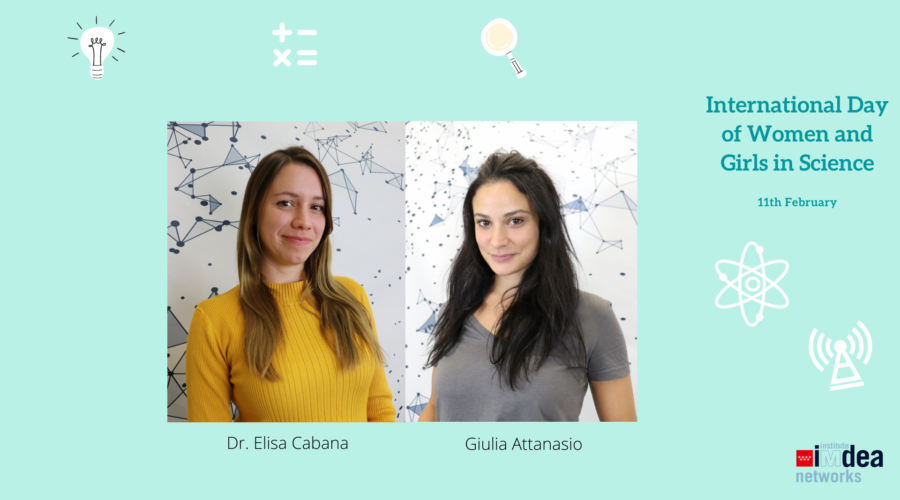IMDEA Networks

Elisa Cabana and Giulia Attanasio, two young researchers who opted for STEM careers
Both are developing their professional careers at IMDEA Networks Institute and are examples of women with a scientific vocation
11 February 2021

The low presence of women studying STEM careers (science, technology, engineering and mathematics) is a global phenomenon. Precisely, in order to achieve access and participation of women and girls in science, every February 11 is celebrated the International Day of Women and Girls in Science, proclaimed by the UN in 2015.
According to the latest data published by UNESCO, “less than 30% of the world’s researchers are women“. This disparity is worrying inasmuch as most of the jobs of the future are linked to these disciplines. “The enrollment of female students is particularly low in the field of information and communications technology (ICT), at just 3%; natural sciences, mathematics and statistics, stand at 5%; and in engineering, manufacturing and construction, 8%,” stated UNESCO in its report published in 2019.
In Spain, the figures are similar to those provided by international organizations. According to university statistics provided by the Ministry of Education and Vocational Training for the 2018-2019 academic year, only 12.9% of those enrolled in computer science are women, and in the case of engineering, construction and industry, the figure stands at 28.5%.
For Dr. Elisa Cabana (30 years old), Post-Doc Researcher at IMDEA Networks, this is “a cyclical problem”. “Few women want to go into science, technology, engineering or mathematics, so there are few or no role models. And if young girls have fewer people to look up to, they often won’t end up in one of these fields. It is extremely difficult for us to achieve our dreams without someone to look up to who has taken the same path.”
Cabana holds a degree in Mathematics from the University of Havana (Cuba) and a master’s and PhD in Mathematical Engineering from the University Carlos III of Madrid. From a very young age, she was curious to know more about the world around her, asking herself questions that had a scientific basis. But it was not until a Logic exam that she discovered her vocation. Although, at first, she hesitated between studying Physics or Biology, in the end she opted for Mathematics. “I realized how beautiful and challenging it is and how many applications it has.”
Giulia Attanasio (28), a PhD student at IMDEA Networks, was just a child when her interest in science was sparked. She used to play with expired medical products that her parents kept in a large box placed in a corner of their garage at home. There, “I used to mix capsules, powders and different types of gels to find out the final result,” she says.
The researcher was looking for answers to endless questions. “I guess that’s the definition of an engineer,” she says. Attanasio acknowledges that “the prospect of having a career in a field that imagines and literally creates the future is a fascinating challenge. In particular, Telecommunications Engineering shortens the distance between people, things and places allowing for countless opportunities.”
Attanasio completed her education with a Master’s degree in Communications and Computer Networks Engineering at the Politecnico di Torino. Currently, her work is focused on machine learning for the optimization and automation of wireless networks and low-latency communications in the millimeter-wave band. For her, the most effective way to increase girls’ interest in these careers is through education. She believes that schools should place special emphasis on the possibilities offered by a career in these fields, “sharing interesting and inspiring stories of women who are making a difference in the scientific world today.”
Lack of role models
Although not the only reasons, the lack of female role models and the difficulty traditionally associated with STEM careers are among the possible explanations for the perpetuation of this gender gap. The scarcity of role models can lead to less confidence and less enthusiasm for orienting future careers towards these areas. In fact, a study published by Science magazine about the perception of science among boys and girls between the ages of 4 and 6 states that girls believe they are less intelligent than their male counterparts from the age of 6 onwards.
Cabana believes that, “in general, there is a tendency to think that girls are not ‘capable enough’ to follow careers in science or engineering. And that couldn’t be further from the truth. There are many women who can exemplify this: Ada Lovelace, Marie Curie, Fei Fei Li and many others.” The key, says the researcher, lies in re-educating ourselves as adults and recognizing that this gap persists today in order to find effective solutions.
For her part, Attanasio agrees that several complex historical and sociological factors play a role: “The greatest impact is from the lack of female role models through the media, as most prominent female scientists work behind the scenes.”
“We need to show that there are many role models in STEM that could inspire girls. We should start doing this from an early age, for example, through outreach events, with activities at school and even at home. And we should also update all history books, because there is an obvious gap between women and men, and an equal representation could help change this situation,” says Cabana.


Recent Comments